2001 MERCEDES-BENZ CLK430 seats
[x] Cancel search: seatsPage 4 of 329

1 Contents
IntroductionProduct information .......................... 7
Operator’s manual ............................. 8
Where to find it ................................ 13
Reporting Safety Defects ................ 15Instruments and controlsInstruments and controls ............... 18
Center console .............................. 20
Overhead control panel ............... 21OperationVehicle keys ...................................... 24
Start lock-out .................................... 27
General notes on the
central locking system ............... 27
Central locking system ................... 28
Radio frequency and infrared
remote control .............................. 28
Opening and closing windows
and sliding/pop-up roof from
outside ........................................... 32Panic button ................................. 33
Mechanical keys .......................... 33
Doors ................................................. 34
Central locking switch .................... 36
Automatic central locking .......... 37
Emergency unlocking in
case of accident .......................... 37
Trunk ................................................. 38
Trunk lid release switch ................ 40
Trunk lid emergency
release ...........................................41
Antitheft alarm system ................... 42
Tow-away alarm ............................... 44
Power seats, front ............................ 45
Front head restraints ...................51
Rear head restraints .................... 52
Backrest ............................................ 54
Multicontour seat ............................ 55
Heated seats ..................................... 56
Seat belts and integrated
restraint system .......................... 58
Seat belts .......................................... 58
Seat belt nonusage
warning system ............................ 59BabySmart
TM airbag
deactivation system .................... 65
Self-test BabySmart
TM without
special child seat installed ......... 65
Supplemental restraint
system (SRS) ................................ 66
Emergency tensioning
retractor (ETR) ............................. 66
Airbags .............................................. 67
Safety guidelines for the
seat belt, emergency
tensioning retractor
and airbag ..................................... 73
Infant and child
restraint systems .......................... 75
Adjusting telescoping
steering column .......................... 78
Inside rear view mirror .................. 79
Exterior rear view mirrors ............. 80
Instrument cluster ........................... 84
Indicator lamps in the
instrument cluster ...................... 86
Multifunction steering wheel,
multifunction display ................. 90
Page 25 of 329
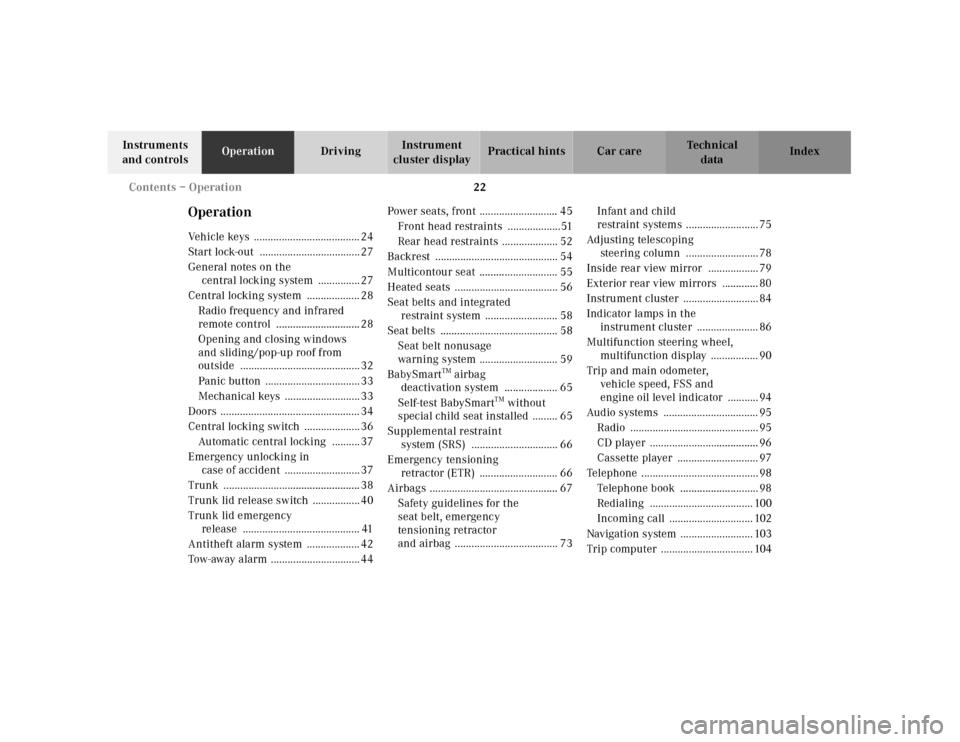
22 Contents – Operation
Te ch n ica l
data Instruments
and controlsOperationDrivingInstrument
cluster displayPractical hints Car care Index
OperationVehicle keys ...................................... 24
Start lock-out .................................... 27
General notes on the
central locking system ............... 27
Central locking system ................... 28
Radio frequency and infrared
remote control .............................. 28
Opening and closing windows
and sliding/pop-up roof from
outside ........................................... 32
Panic button .................................. 33
Mechanical keys ........................... 33
Doors .................................................. 34
Central locking switch .................... 36
Automatic central locking .......... 37
Emergency unlocking in
case of accident ........................... 37
Trunk ................................................. 38
Trunk lid release switch ................. 40
Trunk lid emergency
release .......................................... 41
Antitheft alarm system ................... 42
Tow-away alarm ................................ 44Power seats, front ............................ 45
Front head restraints ...................51
Rear head restraints .................... 52
Backrest ............................................ 54
Multicontour seat ............................ 55
Heated seats ..................................... 56
Seat belts and integrated
restraint system .......................... 58
Seat belts .......................................... 58
Seat belt nonusage
warning system ............................ 59
BabySmart
TM airbag
deactivation system ................... 65
Self-test BabySmart
TM without
special child seat installed ......... 65
Supplemental restraint
system (SRS) ............................... 66
Emergency tensioning
retractor (ETR) ............................ 66
Airbags .............................................. 67
Safety guidelines for the
seat belt, emergency
tensioning retractor
and airbag ..................................... 73Infant and child
restraint systems .......................... 75
Adjusting telescoping
steering column .......................... 78
Inside rear view mirror .................. 79
Exterior rear view mirrors ............. 80
Instrument cluster ........................... 84
Indicator lamps in the
instrument cluster ...................... 86
Multifunction steering wheel,
multifunction display ................. 90
Trip and main odometer,
vehicle speed, FSS and
engine oil level indicator ........... 94
Audio systems .................................. 95
Radio .............................................. 95
CD player ....................................... 96
Cassette player ............................. 97
Telephone .......................................... 98
Telephone book ............................ 98
Redialing ..................................... 100
Incoming call .............................. 102
Navigation system .......................... 103
Trip computer ................................. 104
Page 48 of 329
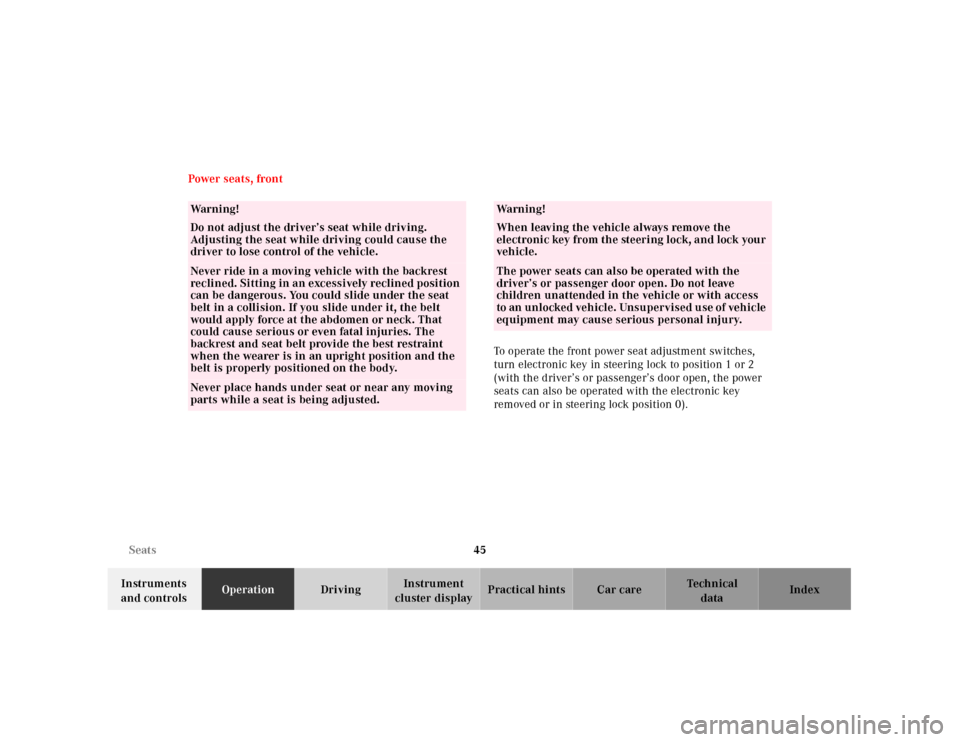
45 Seats
Te ch n ica l
data Instruments
and controlsOperationDrivingInstrument
cluster displayPractical hints Car care Index Power seats, front
To operate the front power seat adjustment switches,
turn electronic key in steering lock to position 1 or 2
(with the driver’s or passenger’s door open, the power
seats can also be operated with the electronic key
removed or in steering lock position 0).
Wa r n i n g !
Do not adjust the driver’s seat while driving.
Adjusting the seat while driving could cause the
driver to lose control of the vehicle.Never ride in a moving vehicle with the backrest
reclined. Sitting in an excessively reclined position
can be dangerous. You could slide under the seat
belt in a collision. If you slide under it, the belt
would apply force at the abdomen or neck. That
could cause serious or even fatal injuries. The
backrest and seat belt provide the best restraint
when the wearer is in an upright position and the
belt is properly positioned on the body.Never place hands under seat or near any moving
parts while a seat is being adjusted.
Wa r n i n g !
When leaving the vehicle always remove the
electronic key from the steering lock, and lock your
vehicle.The power seats can also be operated with the
driver’s or passenger door open. Do not leave
children unattended in the vehicle or with access
to an unlocked vehicle. Unsupervised use of vehicle
equipment may cause serious personal injury.
Page 49 of 329
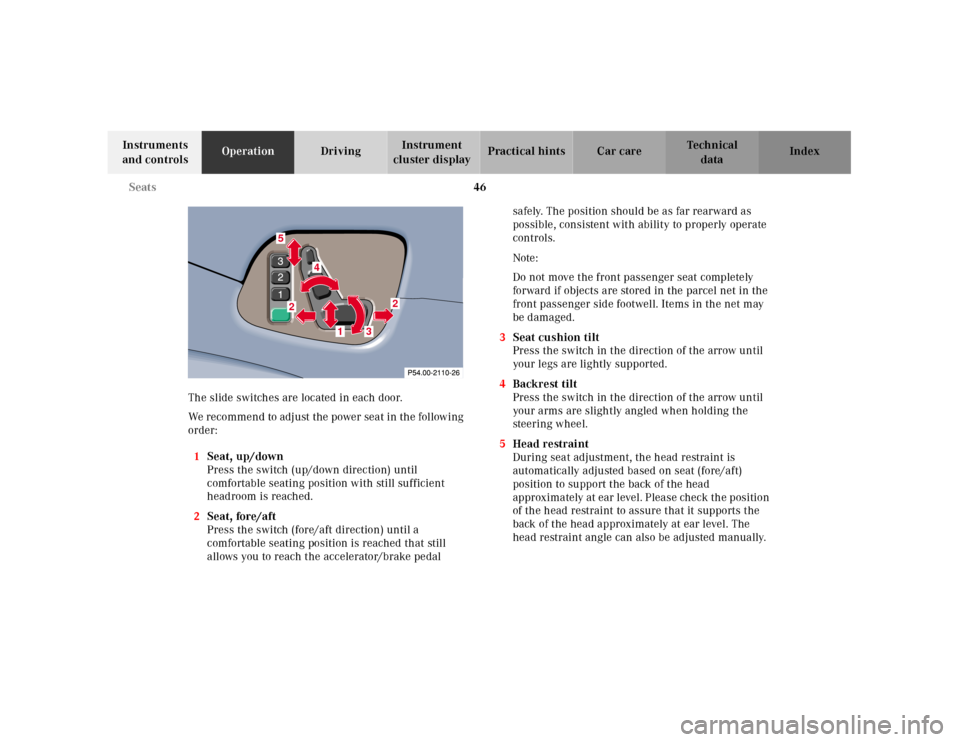
46 Seats
Te ch n ica l
data Instruments
and controlsOperationDrivingInstrument
cluster displayPractical hints Car care Index
The slide switches are located in each door.
We recommend to adjust the power seat in the following
order:
1Seat, up/down
Press the switch (up/down direction) until
comfortable seating position with still sufficient
headroom is reached.
2Seat, fore/aft
Press the switch (fore/aft direction) until a
comfortable seating position is reached that still
allows you to reach the accelerator/brake pedal safely. The position should be as far rearward as
possible, consistent with ability to properly operate
controls.
Note:
Do not move the front passenger seat completely
forward if objects are stored in the parcel net in the
front passenger side footwell. Items in the net may
be damaged.
3Seat cushion tilt
Press the switch in the direction of the arrow until
your legs are lightly supported.
4Backrest tilt
Press the switch in the direction of the arrow until
your arms are slightly angled when holding the
steering wheel.
5Head restraint
During seat adjustment, the head restraint is
automatically adjusted based on seat (fore/aft)
position to support the back of the head
approxima tely at ear l evel . Plea se check th e position
of the head restraint to assure that it supports the
back of the head approximately at ear level. The
head restraint angle can also be adjusted manually.
87
4
52
2
1
3
Page 50 of 329
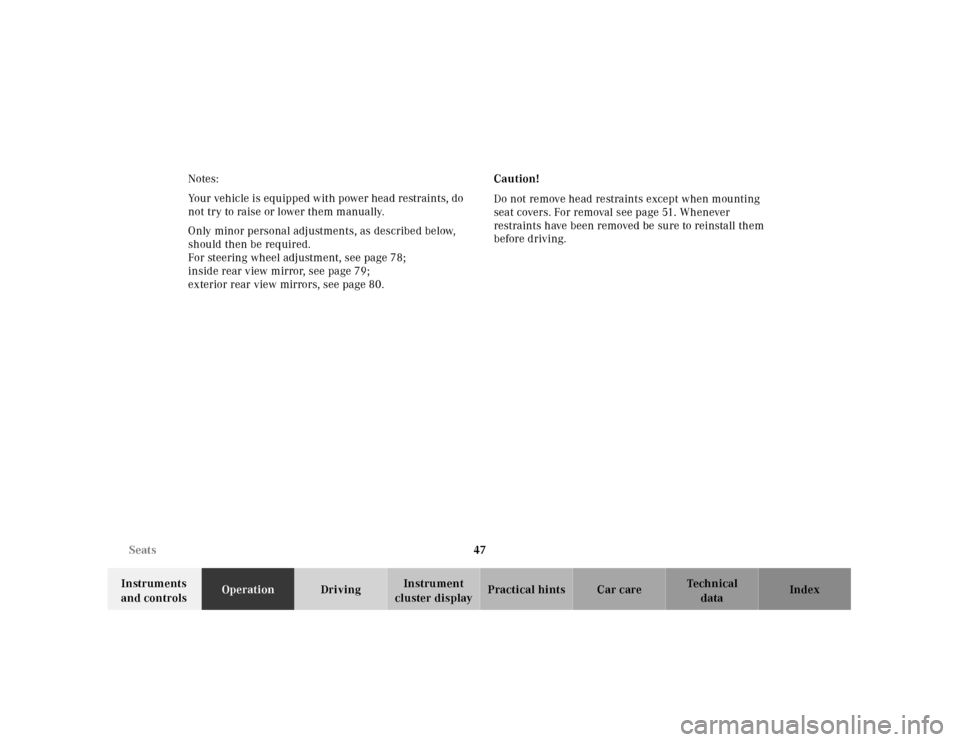
47 Seats
Te ch n ica l
data Instruments
and controlsOperationDrivingInstrument
cluster displayPractical hints Car care Index Notes:
Your vehicle is equipped with power head restraints, do
not try to raise or lower them manually.
Only minor personal adjustments, as described below,
should then be required.
For steering wheel adjustment, see page 78;
inside rear view mirror, see page 79;
exterior rear view mirrors, see page 80.Caution!
Do not remove head restraints except when mounting
seat covers. For removal see page 51. Whenever
restraints have been removed be sure to reinstall them
before driving.
Page 51 of 329
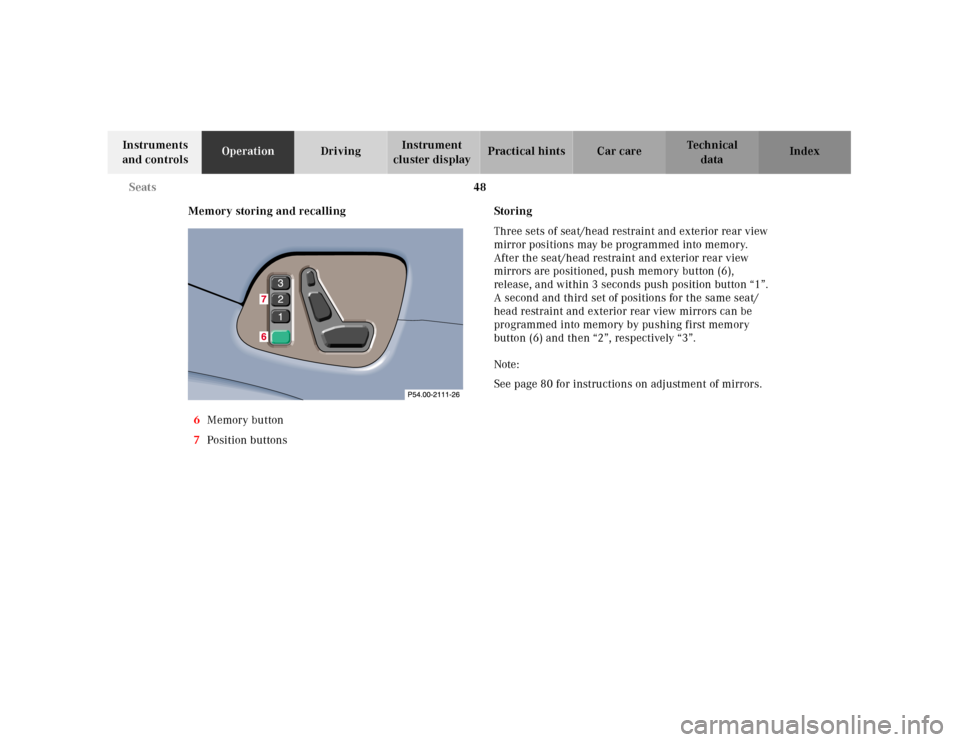
48 Seats
Te ch n ica l
data Instruments
and controlsOperationDrivingInstrument
cluster displayPractical hints Car care Index
Memory storing and recalling
6Memory button
7Position buttonsStoring
Three sets of seat/head restraint and exterior rear view
mirror positions may be programmed into memory.
After the seat/head restraint and exterior rear view
mirrors are positioned, push memory button (6),
release, and within 3 seconds push position button “1”.
A second and third set of positions for the same seat/
head restraint and exterior rear view mirrors can be
programmed into memory by pushing first memory
button (6) and then “2”, respectively “3”.
Note:
See page 80 for instructions on adjustment of mirrors.
Page 52 of 329
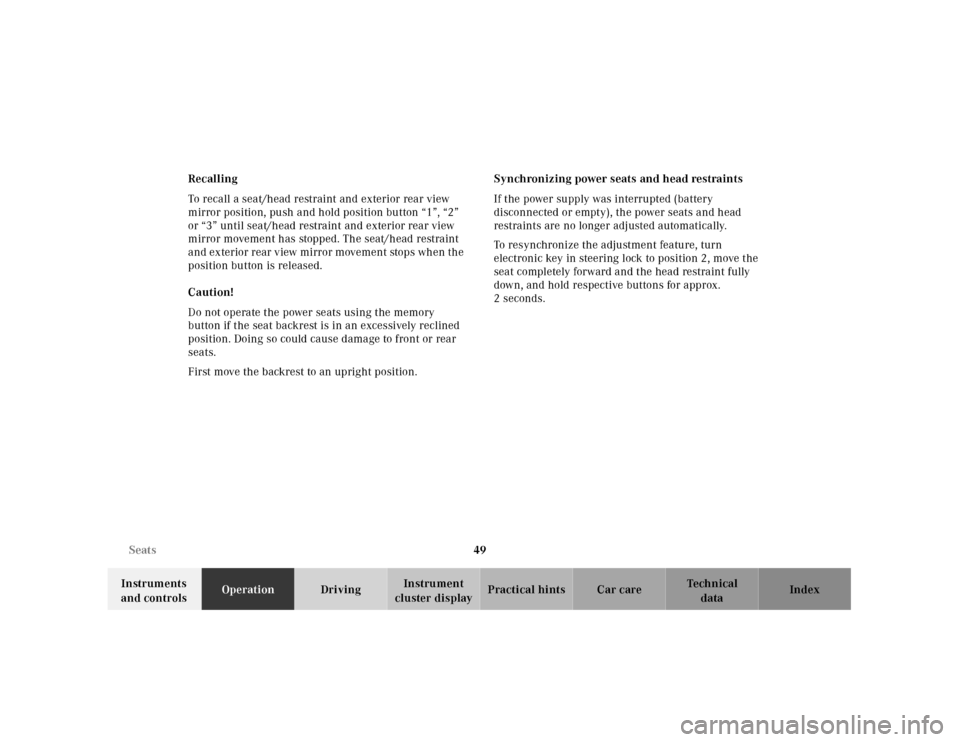
49 Seats
Te ch n ica l
data Instruments
and controlsOperationDrivingInstrument
cluster displayPractical hints Car care Index Recalling
To recall a seat/head restraint and exterior rear view
mirror position, push and hold position button “1”, “2”
or “3” until seat/head restraint and exterior rear view
mirror movement has stopped. The seat/head restraint
and exterior rear view mirror movement stops when the
position button is released.
Caution!
Do not operate the power seats using the memory
button if the seat backrest is in an excessively reclined
position. Doing so could cause damage to front or rear
seats.
First move the backrest to an upright position.Synchronizing power seats and head restraints
If the power supply was interrupted (battery
disconnected or empty), the power seats and head
restraints are no longer adjusted automatically.
To resynchronize the adjustment feature, turn
electronic key in steering lock to position 2, move the
seat completely forward and the head restraint fully
down, and hold respective buttons for approx.
2seconds.
Page 53 of 329
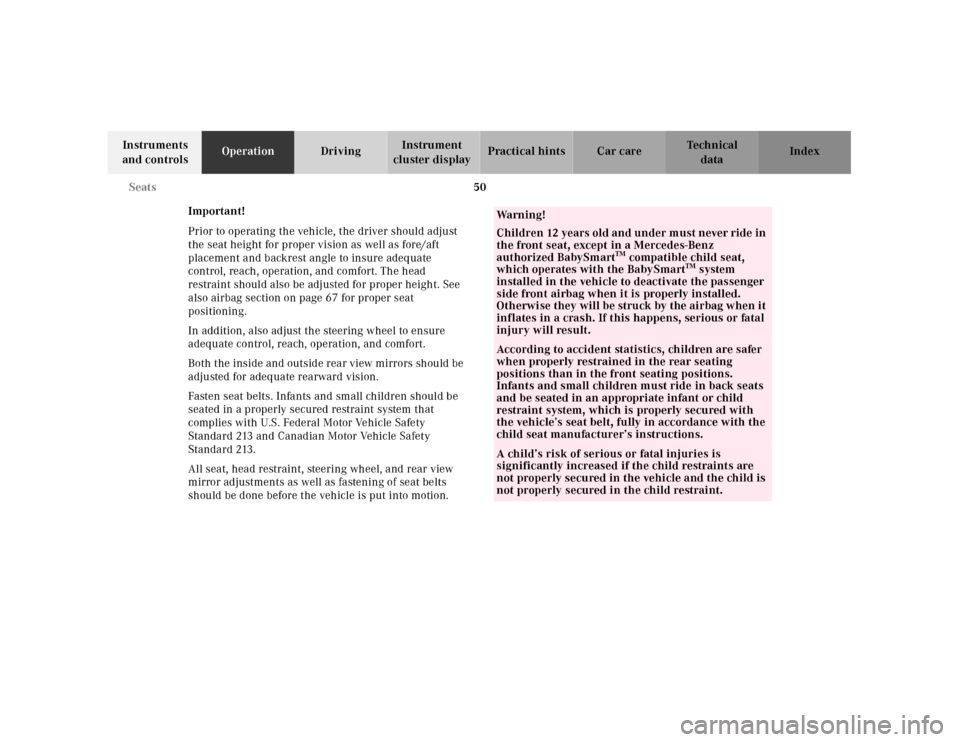
50 Seats
Te ch n ica l
data Instruments
and controlsOperationDrivingInstrument
cluster displayPractical hints Car care Index
Important!
Prior to operating the vehicle, the driver should adjust
the seat height for proper vision as well as fore/aft
placement and backrest angle to insure adequate
control, reach, operation, and comfort. The head
restraint should also be adjusted for proper height. See
also airbag section on page 67 for proper seat
positioning.
In addition, also adjust the steering wheel to ensure
adequate control, reach, operation, and comfort.
Both the inside and outside rear view mirrors should be
adjusted for adequate rearward vision.
Fasten seat belts. Infants and small children should be
seated in a properly secured restraint system that
complies with U.S. Federal Motor Vehicle Safety
Standard 213 and Canadian Motor Vehicle Safety
Standard 213.
All seat, head restraint, steering wheel, and rear view
mirror adjustments as well as fastening of seat belts
should be done before the vehicle is put into motion.
Wa r n i n g !
Children 12 years old and under must never ride in
the front seat, except in a Mercedes-Benz
authorized BabySmart
TM compatible child seat,
which operates with the BabySmart
TM system
installed in the vehicle to deactivate the passenger
side front airbag when it is properly installed.
Otherwise they will be struck by the airbag when it
inflates in a crash. If this happens, serious or fatal
injury will result.
According to accident statistics, children are safer
when properly restrained in the rear seating
positions than in the front seating positions.
Infants and small children must ride in back seats
and be seated in an appropriate infant or child
restraint system, which is properly secured with
the vehicle’s seat belt, fully in accordance with the
child seat manufacturer’s instructions.A child’s risk of serious or fatal injuries is
significantly increased if the child restraints are
not properly secured in the vehicle and the child is
not properly secured in the child restraint.